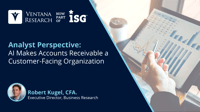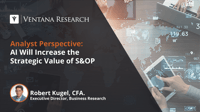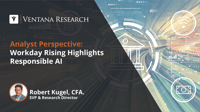Oracle held an industry analyst summit recently where the focus was on artificial intelligence (AI) and embedded AI. At the event, Oracle demonstrated progress in adding useful AI-enabled capabilities to its business applications, especially in finance and accounting, supply chain, HR and revenue management. To put this into context, across the software industry, AI is already at work in many finance-focused applications that are currently available, albeit often in limited release. We are in...
Read More
Topics:
Office of Finance,
Analytics,
Business Planning,
ERP and Continuous Accounting,
AI,
digital finance,
Generative AI,
AI and Machine Learning,
Procure-to-Pay,
Order-to-Cash,
Consolidate and Close Management
Artificial intelligence seems poised to change everything, although naturally a great deal of attention tends to be paid to the cool things it makes possible. AI can also make the humdrum less tedious and even transform the dullest of back-office operations into something more meaningful. For example, AI can take accounts receivable automation to the next level.
Read More
Topics:
Office of Finance,
AI,
digital finance,
AI and Machine Learning,
Order-to-Cash
We live in an era of uncertainty, not unpredictability. Managing in uncertain times is always difficult, but tools are available to improve the odds for success by making it easier and faster to plan for contingencies and scenarios. Software makes it possible to manage ahead of any future event, connecting the tactical trees to the strategic forest. The purpose of planning is not just to create a plan: Enterprises spend time thinking ahead because it enables leadership teams, executives and...
Read More
Topics:
Office of Finance,
Continuous Planning,
Data Management,
Business Planning,
data operations,
digital finance,
AI and Machine Learning
Sales and operations planning (S&OP) is trending toward becoming more strategic in product-centric companies through the end of the decade. The purpose of S&OP has grown in importance. Since the mid-teens, the trade and economic environment has become less benign and more unpredictable, forcing many enterprises to redesign their supply chains for resiliency while still surmounting the dual challenges of remaining cost competitive and achieving financial targets. Over the past decade, there have...
Read More
Topics:
Continuous Planning,
Operations & Supply Chain,
Enterprise Resource Planning,
digital finance,
Sustainability Management,
AI and Machine Learning
Because artificial intelligence is top-of-mind, Workday spent a great deal of time on the topic at its recent Workday Rising annual user group meeting in San Francisco. It was front and center in the general sessions, in the announcements made at the event and in the product roadmaps.
Read More
Topics:
Office of Finance,
Business Planning,
ERP and Continuous Accounting,
digital finance,
Purchasing/Sourcing/Payments,
AI and Machine Learning















